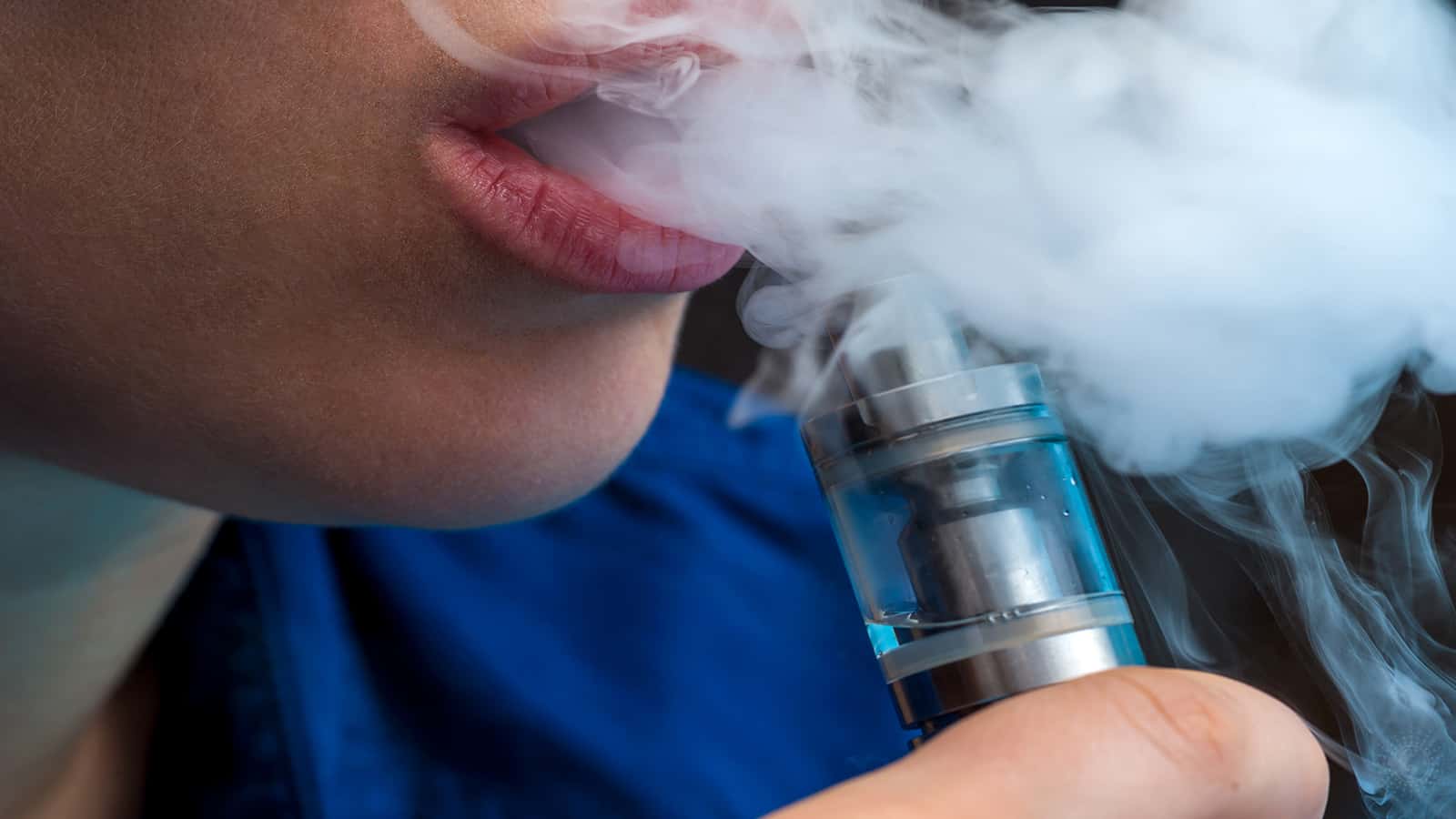Vaping is an addictive habit, but it is possible to give it up. When you quit vaping, you’ll experience many health benefits right away. But what is vaping?
E-cigarettes, vapes, vape pens, or Juul all refer to the same products. Using any of these products is termed “vaping,” which uses a battery-powered device to inhale an aerosol containing nicotine, flavorings, and chemicals. These devices look like regular cigarettes, pipes, cigars or USB sticks, or other normal-looking items like coke cans, a game boy, or a perfume bottle.
History of vaping and e-cigarettes
 Back in the late 2000s, e-cigarettes entered the market. At the time, e-cigarettes were considered a safer alternative than cigarettes. But over time, evidence revealed this wasn’t true. Since then, vaping-related lung diseases have increased. Studies show that when you vape, you introduce a mixture of chemicals to your lungs, including:
Back in the late 2000s, e-cigarettes entered the market. At the time, e-cigarettes were considered a safer alternative than cigarettes. But over time, evidence revealed this wasn’t true. Since then, vaping-related lung diseases have increased. Studies show that when you vape, you introduce a mixture of chemicals to your lungs, including:
- Nicotine
- THC9 marijuana
- Flavonoids
- Propylene glycol
- Vegetable glycerine
Some of these ingredients are only meant to be eaten but not inhaled. Plus, when you heat these ingredients, a chemical reaction isn’t healthy for breathing. Basically, you’re exposing your lungs to chemicals instead of air every day, every week, and every month throughout the year.
Dangerous ingredients in vape products
Besides these chemicals, one hazardous ingredient in some e-cigarettes, Vitamin E acetate, has caused many lung problems. Vitamin E acetate is a form of Vitamin E. used in vaping products as a thickener. It’s usually present in cigarettes with THC, a psychoactive, mood-altering ingredient found in marijuana that causes you to feel high.
A lung disease called EVALI has caused many deaths in people who vaped THC products. The Centers for Disease Control and Prevention (CDC) note that the biggest problem is that vaping products are unregulated, so manufacturers have no standards to follow. This leaves individuals who vape very vulnerable to potentially dangerous harmful chemicals.
The dangers of vaping
Introducing any chemical into your lungs is dangerous. But long-term vaping can result in some severe health problems, including:
- Lung cancer-EVALI
- Heart disease
- Oral cancer
- Gum disease
- Tooth decay
Besides the diseases, vaping can cause unintended physical injuries like burns from devices exploding.
What happens to your body when you stop vaping?
It’s not easy to stop vaping since it is addictive, but many people have quit and found almost immediate benefits. Here are some things that happen to your body when you quit vaping.
1 – Nicotine Withdrawal Symptoms
When you stop vaping, you may not feel well for the first 24 hours. This is because nicotine is a habit-forming substance, and your body and brain react with withdrawal symptoms that make you feel sick. Kicking any habit isn’t easy, and the first 24 hours is when some people give up. Although withdrawal isn’t easy, you can get through it knowing the effects are short-term. Withdrawal symptoms may include:
- Cravings for nicotine
- Moodiness
- Lack of focus
- Anxiety
- Headaches
- Insomnia
- Hunger
- Stomach cramps
- Constipation
- Sweating
- Tremors
What can you do to get through withdrawal?
- Exercise: Get your body moving when you’re going through vaping withdrawal symptoms. Exercise releases some brain chemicals called endorphins. These chemicals make you feel happier. Run, walk, play golf, dance, do yoga, or ride your bike. Do anything to trick your body into not feeling the withdrawal symptoms so much.
- Distract yourself: Find something to do to get your mind off of how you feel. Play a game, listen to a podcast, or paint your living room. Whatever you enjoy doing, spend time on it to distract yourself, especially the first 24 hours after you stop vaping.
- Remove the temptation: If you stop vaping, remove your e-cigarettes. Clean out everything that has to do with vaping. Don’t assume you won’t be tempted to vape if your friends do it. So, ask them not to bring their e-cigarettes to your house or vape around you. If they’re true friends, they’ll want to help you quit rather than make you fail.
- Reduce your stress: Many people vape to reduce their stress, but it won’t solve your problems. Learning how to reduce stress in other ways, such as mindfulness, yoga, or relaxation techniques is better.
2 – Improved circulation system and cardiovascular system
Nicotine slows down the blood flow to your heart and other organs. When you stop inhaling nicotine in vaping, your blood flow increases as your blood vessels return to their standard shape and size. Your blood carries oxygen to your body, so an increase in blood flow means more oxygen resulting in more energy and stamina when doing physical activities.
3 – Better cardiovascular health
As your circulation improves, so will your entire cardiovascular system. When you quit vaping, you’ll have improved the following:
- Heart function
- Arteries will go back to their standard shape and size.
- Veins will carry your blood better.
- Capillaries will allow increased blood flow.
One study found that regular vaping doubles your chances of having a heart attack, even at a young age. But when you quit vaping, your risk of a heart attack diminishes within the first 24 hours.
4 – Less inflammation
Another positive effect when you quit vaping is less inflammation. Vaping causes your white blood cells to react as if you have an infection. Your body stays in a fight-or-flight process that increases your inflammation. Studies show that lung inflammation is one of the side effects of vaping. Once you stop, your white blood cell production decreases, and the inflammation levels decrease. You’ll also have less coughing and shortness of breath.
5 – Food smells and tastes better
Like cigarette smoking, vaping dulls your senses, so you can’t smell or taste foods as well. Your taste and smell will return a couple of days after you stop vaping. You’ll suddenly enjoy the taste of your food and be surprised how much you missed the smell of a burning fire or your partner’s perfume. It’s one of the many benefits you didn’t’ realize you had lost while vaping.
 6 – Less chance of a stroke
6 – Less chance of a stroke
Being young won’t reduce your chances of having a stroke from vaping. When you vape, your blood vessels shrink, causing your blood pressure to go up. These symptoms can lead to a stroke. Once you stop vaping, your risk of a stroke drops quickly. This is because when you stop vaping, your blood vessels return to their average size, your heart will pump more efficiently, and your blood pressure will return to normal. All these things reduce your chances of having a stroke.
7 – Less chance of cancer
Vaping raises your chances of lung, mouth, throat, and pancreatic cancers. A 2019 study found that when mice were exposed to the nicotine found in e-cigarettes for 12 weeks, they had DNA damage to their lungs, bladder, and heart. The same study also discovered that the mice had pre-cancerous and cancerous organ changes, and some developed lung tumors. Researchers are still studying how vaping impacts humans since these findings suggest that e-cigarettes can cause cancer.
8 – Lower blood pressure
Breaking the vaping habit lowers your blood pressure almost immediately. Over time your blood pressure will return to normal, causing you to feel better, have fewer headaches, and reduce your chances of potentially dangerous side effects such as high blood pressure, which can lead to a heart attack or stroke.
9 – Better chance of fighting infections
When you quit vaping, your body’s ability to fight infections returns to normal. While you’re vaping, you risk lung infections because the tiny hair-type structures inside your lungs that remove mucus from your body lose their ability to function correctly. As these hair-like structures get renewed, your lungs are healthier. You’ll have less risk of getting infections and viruses like the flu, bronchitis, or pneumonia. You’ll also breathe quickly and have less shortness of breath when walking or exercising.
10 – Overall better health
Once you stop vaping, your health will continue to improve. Over time, you’ll be as healthy as someone who never vaped. This means your chances of getting cancer, stroke, heart disease, or high blood pressure will be the same as everyone else. This is good news since while you were vaping, your disease risks were relatively high.
 Final thoughts on the recovery you’ll see once you quit vaping
Final thoughts on the recovery you’ll see once you quit vaping
Knowing all the benefits can help motivate you to quit vaping. Although vaping is addictive, it’s possible to kick the habit. Your first twenty-four hours will be the hardest, but you can use some tips listed above to help you stay on track. The fantastic thing is that when you quit vaping, you’ll feel better almost immediately.
Your risk of getting cancer, stroke, or a heart attack will be reduced by almost double. How good is that?




















